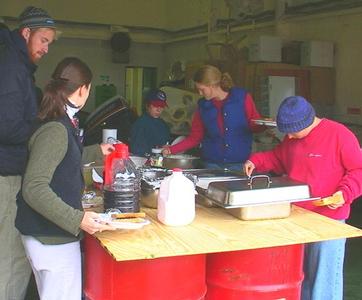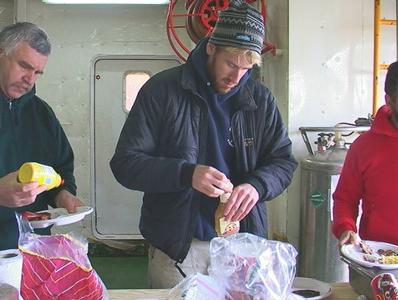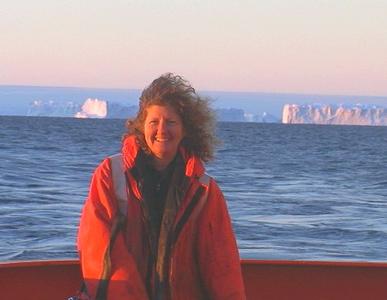20 February, 2001
Longitude 121 46
Latitude -65 23
Continuing from yesterday
After watching the iceberg I was awake so I decided to join the day crew
for the barbecue in the helicopter hanger. There is nothing better than the
smell of a barbecue especially with an iceberg in your "backyard view".
Most Antarctic icebergs begin as great tabular pieces calved from ice
shelves. They are flat-topped and rectangular in shape and can be upwards
of 100 miles in length (do a search about the iceberg threatening Mcmurdo
station, extra credit for how many people the iceberg could provide fresh
water for). From reading my Lonely Planet Guide to Antarctica they say that
the total volume of ice calved each year is about 2,300 cubic km. It has
been estimated that there are about 300,000 icebergs in the southern Ocean
at any given time.
Do you know that solid ice is blue? So why is it that most of what we see
is white? Bubbles! White ice has bubbles trapped inside as it is made from
compressed snow. These air bubbles scatter the light as it enters the ice
so it doesn't have a chance to be absorbed (think of a snow ball). When you
see blue ice it is usually ice that was formed on the bottom of the ice
shelf without these bubbles in it. We can only see the "tip of the
iceberg", the part above the water. This tip can be 50 meters high. The
base on the other hand can be 450 meters deep. That means that about 90% of
an iceberg is below the water. According to Dr. Collin Roesler at that
depth and pressure, seawater freezes to the underside of the ice shelf so
slowly that bubbles don't form.
What I haven't yet seen is green ice. It is a rare site but where we are
going next, the Amery ice shelf, is a source of green icebergs. Green ice
is made from the disintegration of marine plants and animals trapped in the
ice. Blue wavelengths are absorbed by the organic material, red light is
absorbed by the ice and only green wavelengths of light are left over to be
reflected back. The more organic material found in the ice the greener the
it is. (is the same true for water?)* I will let you know if we get to see
one.
*yes.




Contact the TEA in the field at
.
If you cannot connect through your browser, copy the
TEA's e-mail address in the "To:" line of
your favorite e-mail package.
|
